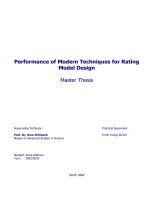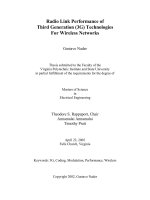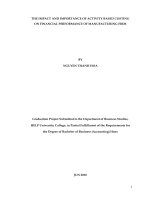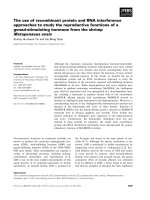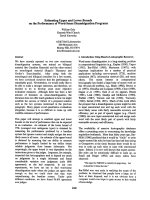30 reproductive performance of hatchery bred donkeys ear abalone, haliotis asinina, linne, fed natural and diets bautista teruel2001
Bạn đang xem bản rút gọn của tài liệu. Xem và tải ngay bản đầy đủ của tài liệu tại đây (76.02 KB, 6 trang )
Aquaculture Research, 2001, 32 (Suppl. 1), 249±254
Reproductive performance of hatchery-bred
donkey's ear abalone, Haliotis asinina, Linne, fed
natural and arti®cial diets
M N Bautista-Teruel, O M Millamena & A C Fermin
Aquaculture Department, South-east Asian Fisheries Development Center, Tigbauan, Iloilo, Philippines
Correspondence: Myrna N Bautista-Teruel, Aquaculture Department, Southeast Asian Fisheries Development Center, Tigbauan, Iloilo,
Philippines, 5021. Tel. +63-33 336-2965. Fax: +63-33 335-1008. E-mail:
Abstract
Introduction
Hatchery-bred donkey's ear abalone, Haliotis
asinina, Linne broodstock were given diets consisting of natural food, seaweed (SW), Gracilariopsis
bailinae, D1; combination of SW and arti®cial diet
(AD), D2; and AD alone, D3. Equal numbers of
1 : 1 female and male abalone were stocked in 24
units, 60 L tanks with eight replicate tanks per
dietary treatment. Reproductive performance, e.g.
number of spawnings, instantaneous fecundity
and egg hatching rates, was monitored over
270 days. The mean number of spawnings was
not signi®cantly different among treatments. The
mean instantaneous fecundity and percent hatching rates were signi®cantly higher in abalone fed
D2 or D3 compared to those given D1. Survival of
abalone broodstock fed D1 was, however, signi®cantly higher at 88% than those fed either D2
or D3 at 75%. Fatty acid analysis showed that
the n-3/n-6 fatty acid ratios of abalone hepatopancreas re¯ected those of their diets. Mature
abalone ovary had n-3/n-6 fatty acid ratio of
1.3. A higher amount of essential nutrients in
the arti®cial diet such as protein, lipid and the
highly unsaturated fatty acids, e.g. 20 : 4n-6,
20 : 5n-3, 22 : 6n-3 in abalone fed D2 or D3,
may have in¯uenced the increased reproductive
performance.
The decreasing commercial catch, and the high
price that abalone command in both the domestic
and export markets, have stimulated great interest in the development of its aquaculture (FAO
1998). A major constraint to development of
abalone aquaculture is the declining supply of
seed from the wild due to overexploitation and
habitat destruction (Jarayabhand & Paphavasit
1996). Although spontaneous spawning of abalone
is
reported
to
occur
year-round
(Singhagraiwan & Doi 1992; Singhagraiwan &
Doi 1993; Capinpin, Encena & Bayona 1998),
production of good quality larvae is very inconsistent. Thus, there is a need to develop a reliable
technique for abalone broodstock development
through dietary manipulation.
Nutrition of broodstock has a profound effect
on gonadal maturation and fecundity (Watanabe
1988), and plays a major role in reproductive
success in both ®sh and crustaceans (Yu,
Sinnhuber, & Hendricks 1979; Takeuchi, Ishii,
& Ogino 1981; Teshima & Kanazawa 1983;
Watanabe,
Itoh,
Murakami,
Tukashima,
Kitajima, & Fujita 1984). There are no published
studies on the in¯uence of nutrition on the
reproductive performance of abalone broodstock,
despite their importance in abalone aquaculture.
Thus, this study was undertaken to investigate
the effects of natural and arti®cial diets on
reproduction of the donkey's ear abalone,
Haliotis asinina, Linne.
Keywords: broodstock, nutrition, abalone, Haliotis
asinina
ã 2001 Blackwell Science Ltd
249
Reproductive performance of abalone M N Bautista-Teruel et al. Aquaculture Research, 2001, 32 (Suppl. 1), 249±254
Table 1 Percentage composition of arti®cial abalone
broodstock diet (g kg±1diet)
Ingredients
Amount (g kg±1 diet)
Fish meal
Shrimp meal
Defatted soybean meal
Rice bran
Wheat ¯our
Seaweed (Gracilaria sp.) (powdered)
Tuna oil
Soybean oil
Vitamin mix*
Mineral mix**
Dicalcium phosphate
Butylatedhydroxy toluene
100
100
200
119.5
200
170
5
5
30
40
30
0.5
Crude protein
Crude fat
Nitrogen-free extract
Estimated energy (kcal kg±1)2
Natural diet1
Arti®cial diet
17.56
0.48
35.38
2161
25.40
4.38
47.59
3315
1
Seaweed, Gracilariopsis bailinae.
Computed based on standard physiological fuel values of
9 kcal g±1 lipid and 4 kcal g±1 protein and carbohydrates
(Brett & Groves 1979).
2
*Vitamin and mineral mixes, commercial brand. Vitamin
A (3.0 M.I.U kg±1), Vitamin D3 (0.6 M.I.U kg±1), Vitamin
B1 (3.60 g kg±1), Vitamin B2 (7.20 g kg±1), Vitamin B6
(6.60 g kg±1), Vitamin B12 (0.02 g kg±1), Vitamin E
(16.50 g kg±1), Vitamin K3 (2.40 g kg±1), Niacin
(14.40 g kg±1), Pantothenic acid (4.00 g kg±1), Biotin
(0.02 g kg±1), Folic Acid (1.20 g kg±1), Inositol
(30.00 g kg±1), Stable C (100.00 g kg±1).
**Mineral mix. P (12.00%), Ca (12.00%), Mg (1.50%), Fe
(0.15%), Zn (0.42%), Cu (0.21%), K (7.50%), Ge
(0.0001%), Co (0.011%), Mn (0.160%), Se (0.001%), Mo
(0.0005%), Al (0.0025%), I (0.04%), B (0.0001%), Ni
(0.0001%).
Materials and Methods
Experimental diets
Dietary treatments consisted of a natural diet,
seaweed (Gracilariopsis bailinae) (D1), combination
of natural and arti®cial diets (D2), and arti®cial diet
(D3). Seaweed was given every 4 days, ad libitum.
The combination diet was given alternately each
day. Arti®cial diet was a modi®cation of a previous
formulation of Bautista-Teruel & Millamena (1999)
in that the amount of some ingredients, e.g. shrimp
meal, tuna and soybean oils, was reduced while
adding more of the others, e.g. rice bran, seaweed.
The composition and proximate composition of the
natural and arti®cial diets are shown in Tables 1
and 2, respectively. Treatments were arranged in a
completely randomized experimental design.
Abalone broodstock fed diets D2 and D3 were
initially fed D1 and gradually switched to the
arti®cial diet by the second week of culture.
Formulated diet was given at 3±5% of broodstock
250
Table 2 Proximate composition (%) of natural and
arti®cial diet for broodstock abalone, Haliotis asinina,
Linne
biomass once daily at 16.00±17.00 hours. Excess
diet was removed and the feeding rate was adjusted
based on weight gain after each sampling, which
was done every 2 weeks. Mortalities were recorded
daily.
Abalone culture and rearing system
Experiments were conducted at the wet laboratory
of the SEAFDEC Aquaculture Department in Iloilo,
the Philippines. Abalone, Haliotis asinina, adults
with initial mean body weight of 24.5 T 0.12 g
and shell length of 48.5 T 0.68 mm were obtained
from the mollusc hatchery at SEAFDEC, Tigbauan,
Iloilo. Gonadal maturity of the female abalone was
judged according to the criteria developed by
Singhagraiwan & Doi (1993). Abalone having
immature gonads were used in the study.
Forty-eight male and female abalone were
stocked at a 1 : 1 ratio into 24 units, 60-L ®breglass
tanks with eight replicate tanks per dietary treatment. Halved PVC pipes were provided in each tank
as shelter for abalone. Sand-®ltered seawater was
supplied in a ¯ow-through system equipped with
adequate aeration. Tanks were cleaned of faeces and
excess diet whenever necessary.
Abalone broodstock were checked for spawning
each day in the early morning. Eggs were siphoned
and counted in 40-L ®breglass tanks located just
under the spawning tanks. Instantaneous fecundity
was computed as the total number of spawned eggs
per g body weight of abalone. Percent hatching rate
was computed as the total number of larvae divided
by the total number of spawned eggs multiplied by
100.
ã 2001 Blackwell Science Ltd, Aquaculture Research, 32 (Suppl. 1), 249±254
Aquaculture Research, 2001, 32 (Suppl. 1), 249±254 Reproductive performance of abalone M N Bautista-Teruel et al.
Table 3 Reproductive performance
of abalone, Haliotis asinina, Linne,
broodstock fed natural diet alone,
combination of natural and arti®cial
diets, and arti®cial diet alone
Treatment1
Parameter
D1
Mean number of spawnings
Mean instantaneous fecundity
Mean hatching rate (%)
Broodstock survival (%)
Mean frequency of spawning/month
Mean spawning time interval (days)
8.0 T 0.6a
4077 T 67.8
39.49 T 8.2a
88 T 7.6a
1±2
19 T 1.8
D2
a
9.0
5478
46.22
75
1±2
17
D3
T
T
T
T
1.8a
45.8b
7.3b
12.5b
T 1.3
9.5
5050
45.65
75
1±2
16
T
T
T
T
1.2a
74.1b
11.2b
12.5b
T 0.7
1
Treatment means with different superscripts are signi®cantly different
(P < 0.005).
D1 = Seaweed, Gracilariopsis bailinae (natural diet) (given alone).
D2 = Seaweed (natural diet) + arti®cial diet given alternately.
D3 = arti®cial diet (given alone)
Table 4 Comparison
of
fatty
acid
composition
(percentage of total lipid) of natural and arti®cial diets for
abalone, Haliotis asinina, Linne, with mature ovary of the
wild abalone
Fatty acid
Natural diet
Arti®cial diet
Mature ovary1
14 : 0
15 : 0
16 : 0
16 : 1n-7
18 : 0
18 : 1n-7
18 : 2n-6
18 : 3n-3
18 : 4n-3
20 : 4n-6
20 : 5n-3
20 : 5n-6
22 : 5n-3
22 : 6n-3
Total n-3
Total n-6
n-3/n-6
6.6
2.3
29.2
1.4
1.5
15.5
10.9
16.8
7.0
2.1
1.8
0.9
3.2
0.7
28.5
14.4
2.0
16.5
1.5
20.1
2.3
1.8
22.8
13.4
7.5
1.2
2.4
3.9
0.8
0.8
3.8
17.2
16.5
1.0
12.9
3.8
22.9
1.3
2.4
20.5
10.8
5.9
1.5
3.1
5.1
1.2
2.3
5.2
20.0
15.1
1.3
methods (AOAC 1995). Fatty acid composition of
the diets and abalone muscle tissues were determined by gas-liquid chromatography (GLC). Total
lipids were extracted using the method of Bligh &
Dyer (1959). Methyl esters of constituent fatty acids
were prepared by the saponi®cation-transesteri®cation method of Metcalfe, Schmitz, & Pelka (1966).
Fatty acid composition of replicate samples was
analysed using a Shimadzu GC 9A (Shimadzu Co.,
Tokyo, Japan) gas chromatograph with a ¯ame
ionization detector (FID) ®tted with 15% diethylene
glycol succinate column on chromosorb support.
The gas chromatograph was operated isothermally
at 190 °C with a 30 mL min±1 ¯ow of nitrogen. Fatty
acids were identi®ed using authentic standards and
published values for fatty acid marine oils (Ackman
& Burgher 1965) and quanti®ed with an electronic
integrator (Shimadzu Chromatopac CR-2AX).
Results are presented as the weight percentage of
total fatty acids.
1
Statistical analysis
Water temperature (26±30 °C) and salinity (32±
35 g L±1) were monitored daily. Ammonia nitrogen
(0±0.08 mg L±1), nitrite nitrogen (0.0±0.17 mg L±1)
and dissolved oxygen (4.6±7.1 mg L±1) were
monitored weekly. Water quality remained within
ranges suitable for abalone culture in tanks.
Data were analysed using analysis of variance
(Gomez & Gomez 1984) and Duncan's multiple
range test (P ` 0.05) to test signi®cant differences
among treatment means (Duncan 1955). Arcsin
transformation of percentage data was done prior to
statistical analysis. Replicate tanks were considered
units of observation for ANOVA testing.
Chemical analyses
Results
Natural and formulated diets were analysed for
proximate composition according to standard
The effects of the different diets on reproductive
performance of broodstock abalone are shown in
Mature ovary from wild abalone
ã 2001 Blackwell Science Ltd, Aquaculture Research, 32 (Suppl. 1), 249±254
251
Reproductive performance of abalone M N Bautista-Teruel et al. Aquaculture Research, 2001, 32 (Suppl. 1), 249±254
Table 5 Fatty acid composition (percentage of total lipid)
of hepatopancreas of abalone, Haliotis asinine, Linne, fed
natural diet alone, combination of natural and arti®cial
diets and arti®cial diet alone
Hepatopancreas
Discussion
Fatty acids
D1
D2
D3
14 : 0
15 : 0
16 : 0
16 : 1n-7
18 : 0
18 : 1n-7
18 : 2n-6
18 : 3n-3
18 : 4n-3
20 : 4n-6
20 : 5n-3
20 : 5n-6
22 : 5n-3
22 : 6n-3
Total n-3
Total n-6
n-3/n-6
9.3
4.1
21.2
5.8
5.7
17.9
9.4
13.5
5.3
2.1
1.8
0.8
2.8
0.7
24.1
12.3
2.0
12.2
7.2
22.1
1.9
6.4
19.2
10.5
8.3
0.9
3.2
2.8
0.6
1.2
2.5
15.7
14.3
1.1
14.0
6.3
23.2
2.2
9.2
18.6
8.9
5.2
1.2
2.4
3.7
0.7
0.9
3.1
14.1
12.0
1.2
D1 = Seaweed, Gracilariopsis bailinae (natural diet) (given
alone).
D2 = Seaweed (natural diet) + arti®cial diet given alternately.
D3 = arti®cial diet (given alone)
Table 3. Mean number of spawnings ranged from
8.0 T 0.6 to 9.5 T 1.2 and were not different
among treatments (P > 0.05). Spawning occurred
once or twice every 4 weeks. The time interval
between spawnings varied from 15 to 35 days. The
mean instantaneous fecundity (5478 T 45.8, D2;
5050 T 74.1, D3) and percent hatching rates
(46.22 T 7.3, D2; 45.65 T 11.2,D3) were higher
(P < 0.05) in abalone fed D2 or D3 compared to
those fed D1 (mean instantaneous fecundity = 4077 T 67.8;
percent
hatching
rate = 39.49 T 8.2). Survival of abalone broodstock fed D1 was however, signi®cantly higher
(88%) than those fed either D2 or D3 (75%).
Table 4 shows the fatty acid pro®les of the
natural and arti®cial diets. The natural diet had
higher n-3/n-6 ratio (2.0) compared to arti®cial diet
(1.0). Mature abalone ovary from the wild abalone
had n-3/n-6 ratio of 1.3, whereas those of the
hepatopancreas were more of a re¯ection of their
diets. (Table 5). Highly unsaturated fatty acids
252
(HUFA), e.g. 20 : 4n-6, 20 : 5n-3, 22 : 6n-3, were
present in relatively higher amount in the arti®cial
diets as compared with those found in the natural
diet.
The higher reproductive performance in terms of
total number of spawnings, instantaneous fecundity
and hatching rates of abalone Haliotis asinina fed the
combination of natural and arti®cial diets or the
arti®cial diet alone would suggest that the nutritional quality of the broodstock diet in¯uences
reproduction. Although it is possible to mature
and spawn abalone with natural diet, the provision
of an effective arti®cial diet fed alone or in
combination with the natural diet can achieve
better reproductive performance of the abalone
broodstock. This may result in the enhancement
of production of quality seeds for abalone hatcheries. Dietary nutrients, especially in terms of
proteins, lipids, and fatty acids, e.g. 20 : 4n-6;
20 : 5n-3, 22 : 6n-3, which are essential in reproduction and that are insuf®cient in the natural diet,
may have been compensated by feeding the arti®cial
diet as a supplement or as total food for the abalone.
Proteins that are associated with essential fatty
acids and are usually mobilized to the gonads are
considered important components for reproductive
functions (Harrison 1991). Highly unsaturated fatty
acids (HUFAs) are important nutrients for reproductive functions of ®sh and crustaceans
(Millamena, Primavera, Pudadera & Caballero
1986; Millamena 1989; Millamena & Quinitio
2000). Watanabe, Takeuchi, Ogino & Kawabata
(1977) have also demonstrated that essential fatty
acids play as important a role in reproductive
physiology in ®sh as in higher animals. The results
obtained in red sea bream fed essential fatty acidde®cient diets for 6 months before spawning indicated that the total egg production and hatchability
were signi®cantly in¯uenced by the level of these
essential fatty acids in the diet (Watanabe et al.
1984).
The n-3/n-6 fatty acid ratios of the hepatopancreas re¯ected those of their diets at 2.0 (D1), 1.1
(D2) and 1.2 (D3) (Table 5). Cahu, Fauvel, &
Aquacop (1986) and Millamena (1989) reported a
correlation between dietary fatty acid composition,
tissue fatty acid pattern and quality of eggs in
shrimp, Penaeus monodon. Dietary HUFAs and n-3/
n-6 ratio that simulate that of mature ovaries have
ã 2001 Blackwell Science Ltd, Aquaculture Research, 32 (Suppl. 1), 249±254
Aquaculture Research, 2001, 32 (Suppl. 1), 249±254 Reproductive performance of abalone M N Bautista-Teruel et al.
been reported to improve reproductive performance
and hatchability of eggs in the tiger shrimp
(Millamena 1989). This could partly explain why
better reproductive performance was obtained with
the combination of natural and arti®cial diet or
arti®cial diet given solely. The type of macroalgae
consumed can offer different proportions of nutritionally important PUFA (Dunstan, Baillie, Barrett,
& Volkman 1996; Mai, Mercer, & Donlon 1996). In
this experiment, the amount of PUFA provided by
the natural diet, which is the seaweed Gracilariopsis
bailinae, may not have been as suf®cient as the one
provided in the arti®cial diet. The essential nutrients
such as proteins, lipids, and fatty acids, which are
limiting in the natural diet may have been
compensated by the amounts present in the arti®cial
diet, thus better reproductive performance resulted
in abalone fed D2 or D3. The lower survival of the
abalone fed either D2 or D3 may indicate that more
spawnings that were undergone by the abalone fed
these diets might have contributed to more stressful
activity, thus leading to higher mortalities. Feeding
abalone broodstock with suitable arti®cial diet may
enhance their reproductive performance.
Acknowledgements
The authors wish to acknowledge the assistance of
Ms M. Mallare and Mr N. Entusiasmo in the conduct
of the study; Ms F. Jarder for the proximate analysis;
Ms A. Asutilla for the water analysis; Ms I.
Borlongan for the use of the gas chromatograph;
and Mr R. Sanares for the statistical analysis of the
data. The Organizing Committee of The Ninth
International Symposium on Nutrition and
Feeding in Fish through the Chairman, Dr T.
Watanabe, and South-east Asian Fisheries
Development Center through the Chief, Dr R.
Platon, are likewise gratefully acknowledged for
funding support.
References
Ackman K.G. & Burgher R.G. (1965) Cod liver oil fatty
acids as secondary reference standards in GLC of
polyunsaturated fatty acids of animal origin: analysis
of the dermal oil of the Atlantic leatherback turtle.
Journal of the American Oil Chemists' Society 42, 38±42.
AOAC (1995) In: Of®cial Methods of Analysis of the
Association of Of®cial Analytical Chemists 16th edn (ed.
by S. Williams). Association of Of®cial Analytical
Chemists, Arlington, VA.
Bautista-Teruel M.N. & Millamena O.M. (1999) Diet
development and evaluation for juvenile abalone,
Haliotis asinina: protein/energy levels. Aquaculture 178,
117±126.
Bligh E.G. & Dyer W.J. (1959) A rapid method of total lipid
extraction and puri®cation. Canadian Journal of
Biochemistry and Physiology 37, 912±917.
Brett J.R. & Groves T.D. (1979) Physiological energetics.
In: Fish Physiology, Vol. 8 (ed, by W.S. Hoar, &
D.J.Randall), pp. 599±675. Academic Press, New
York.
Cahu C. & Fauvel C. (1986) Effect of Food Fatty Acid
Composition of Penaeus vannamei Broodstock on Egg
Quality. Council Meeting of the International Council
for the Exploration of the Sea (ICES), Copenhagen,
Denmark. 8pp.
Capinpin E., Encena V. & Bayona N. (1998) Studies on the
reproductive biology of donkey's ear abalone, Haliotis
asinina, Linne. Aquaculture 166, 141±150.
Duncan D.B. (1955) Multiple range and multiple F-tests.
Biometrics 11, 1±42.
Dunstan G.A., Baillie H.J., Barrett S.M. & Volkman J.K.
(1996) Effect of diet on the lipid composition of wild and
cultured abalone. Aquaculture 140, 115±127.
FAO (1998) Yearbook of Fisheries Statistics, Vol. 83. FAO
Fisheries Series, no. 51, 179. FAO, Rome.
Gomez K.A. & Gomez A.A. (1984) Statistical Procedures for
Agricultural Research. The International Rice Research
Institute, Los Banos, Laguna, The Philippines.
Harrison K.E. (1991) Crustacean Reproduction Nutrition.
In: The Crustacean Nutrition Newsletter World Aquaculture
Society International Working Group on Crustacean
Nutrition (ed. by J. D. Castell & K.E. Corpron), Halifax,
N.S., Canada, pp. 62±70.
Jarayabhand P. & Paphavasit N. (1996) A review of the
culture of tropical abalone with special reference to
Thailand. Aquaculture 140, 159±168.
Mai K., Mercer J.P. & Donlon J. (1996) Comparative
studies on the nutrition of two species of abalone,
Haliotis tuberculata L. and Haliotis discus hannai Ino. V.
The role of polyunsaturated fatty acids of macroalgae in
abalone nutrition. Aquaculture 139, 77±89.
Metcalfe L.D., Schmitz A.A. & Pelka J.R. (1966) Rapid
preparation of fatty acid esters from lipids for gas
chromatographic analysis. Analytical Chemistry 38,
514.
Millamena O.M. (1989) Effect of fatty acid composition of
broodstock diet on tissue fatty acid patterns and egg
fertilization and hatching in pond-reared Penaeus
monodon Fabricius broodstock. Asian Fisheries Science
22, 127±134.
Millamena O.M., Primavera J.H., Pudadera R.A. &
Caballero R.V. (1986) The effect of diet on the
reproductive performance of pond-reared Penaeus
monodon Fabricius broodstock. The First Asian Fisheries
Forum, 1, 593±596.
ã 2001 Blackwell Science Ltd, Aquaculture Research, 32 (Suppl. 1), 249±254
253
Reproductive performance of abalone M N Bautista-Teruel et al. Aquaculture Research, 2001, 32 (Suppl. 1), 249±254
Millamena O.M. & Quinitio E. (2000) The effects of diets on
reproductive performance of eyestalk ablated and intact
mud crab Scylla serrata. Aquaculture 181, 81±90.
Singhagraiwan T. & Doi M. (1992) Spawning pattern and
fecundity of the donkey's ear abalone, Haliotis asinina,
Linne, observed in captivity. Thai Marine Fisheries
Research Bulletin 3, 61±69.
Singhagraiwan T. & Doi M. (1993) Seed Production and
Culture of Tropical Abalone Haliotis asinina, Linne. The
Research Project of Fishery Resource Development in
the Kingdom of Thailand, The Eastern Marine Fisheries
Development Center, Department of Fisheries, Ministry
of Agriculture and Cooperatives, Thailand.
Takeuchi M., Ishii S. & Ogino T. (1981) Effect of dietary
vitamin E on growth, vitamin E distribution, and
mortalities of the fertilized eggs and fry in Ayu,
Plecoglossus altivelis. Bulletin of the Tokai Regional Fish
Laboratory 104, 111±122.
Teshima S. & Kanazawa A. (1983) Variation in lipid
composition during the ovarian maturation of the
prawn. Bulletin of the Japanese Society of Scienti®c
Fishery 49, 957±962.
Watanabe T. (1988) Fish Nutrition and Mariculture. The
254
General Aquaculture Course. Kanagawa International
Fisheries Training Center, JICA, Kanagawa Prefecture,
Kanagawa, Japan.
Watanabe T., Itoh A., Murakami A., Tukashima Y.,
Kitajima C. & Fujita S. (1984) Effects of nutritional
quality of diets given to broodstock on the verge of
spawning on reproduction of red sea bream. Bulletin
of the Japanese Society of Scienti®c Fishery 50, 1023±
1028.
Watanabe T., Ohhashi S., Itoh A., Kitajima C. & Fujita S.
(1984) Effects of nutritional composition of diets on
chemical components of red sea bream broodstock and
eggs produced. Bulletin of the Japanese Society of Scienti®c
Fishery 50, 503±515.
Watanabe T., Takeuchi T., Ogino C. & Kawabata T. (1977)
Effect of alpha-tocopherol de®ciency on carp. VII. The
relationship between dietary levels of linoleate and
alpha-tocopherol requirement. Bulletin of the Japanese
Society of Scienti®c Fishery 43, 935±946.
Yu T.C., Sinnhuber R.D. & Hendricks J.D. (1979)
Reproduction and survival of rainbow trout fed
linolenic acid as the only source of essential fatty
acids. Lipids 14, 572±575.
ã 2001 Blackwell Science Ltd, Aquaculture Research, 32 (Suppl. 1), 249±254
